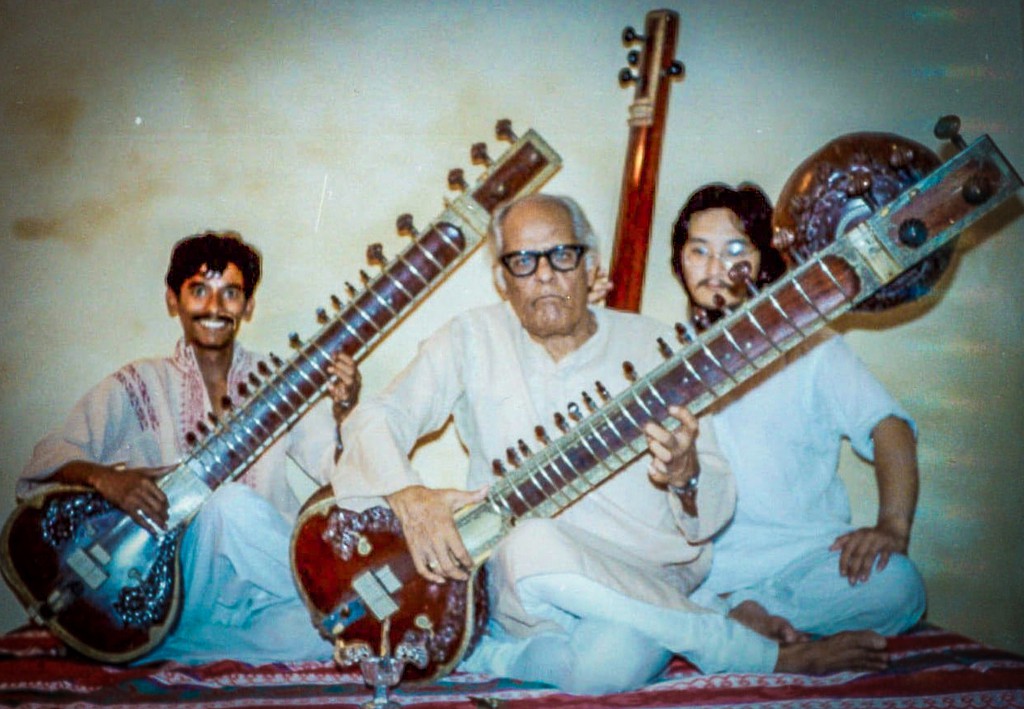There is a very special sitar on my workbench. Special in many ways because it belonged to Ustad Ilyas Khan (1924-1989), a lesser known but highly skilled and deserving sitar player, born in Lucknow to a family of musicians. His father belonged to the Shahjahanpur gharana.

This unique Hiren Roy sitar now belongs to German sitarist Matyas Wolter. In spring 2023, he sent me for a list of problems:
A. Structural Issues:
> Open the tabli and neck plate and tighten all loose points
> If it is opened once anyways, maybe it could be tried to straighten the neck???!!!
B. Cosmetics:
> Spot repair of torn polish spot in front of lower bridge leg on the tabli
> Spot repair of gourd pimples
C. Setup:
> All obvious works: fret binding & setting, new strings etc
> Original Horn bridge adjustment, and (possibly after neck repair) heightening
Since this is a larger project, I have split the report into 2 parts. Below is the first part concerning basic repair:

The sitar almost fell apart by itself. It had once been glued with rohlam, a traditional wood glue made from a mixture of wheat flour, lime and copper sulphur. After a (long) time, it came apart easily.

So taking the instrument apart wasn’t too bad. The neck came off easily with a couple of scrapers inserted and almost immediately the whole tabli came off too.
Matyas had noted earlier that the tabli was probably loose, and that was no overstatement.
The joint on the other hand was still firmly attached, but once the 4 screws were loosened, it too came apart perfectly.

By special request from Matyas, I have put a message to the inside of the neck plate:
“This sitar was made by Hiren Roy of Calcutta in the early 1960’s for Ustad Ilyas Khan of Lucknow and was his main sitar until he passed away in 1989. Thereafter his son Idris Khan took care of it. After Idris’ demise in 2013 Ilyas Khan’s nephew Ustad Irfan Khan of Calcutta took over. He passed the instrument on to his German disciple Matyas Wolter in 2023. It was completely restored for a new life by Klaas Janssens at Sitarfactory / Belgium in 2023.”

The various parts were then well cleaned and cleared of rohlan residue. I then glued them back together with modern hide glue. First up was the neck as it was slightly warped. Then the tabli was put back on. Everything was fixed and held as per the traditional way, with rope…

After a few days of drying, the next step came: the tumba. Matyas had noticed strange bulges, gourd pimples, on the surface and now a little later I came to a peculiar discovery. There were screws under the surface. Due to the effect of rust, and probably also the metal expanding and contracting, slight bulges formed on them over time.

I had never experienced this construction before and still wonder about the purpose of these screws. I can only imagine that they served to help improve the natural shapes of the harvested pumpkin so that it could be made nice and round. The screws probably served to hold the various cuts firmly together again. This is no longer necessary with today’s modern wood glues, which make a good solid joint.

As you can see from the photos, quite a few adjustments were made. I then removed all the bulges, cleaned them well and then gave them a new coat of wood glue/wood dust mixture.

Finally, after this exceptional job, the finishing procedure follows: tumba colouring, body polishing, fitting frets and bridges and finally new strings on… Because the neck is now nicely straight again, the height of the strings changes and so the height of the bridge has to be adjusted as well.

A second report will come soon with more info and photos of the final result.
This sitar still has a mystery… click here for the second part.











































































